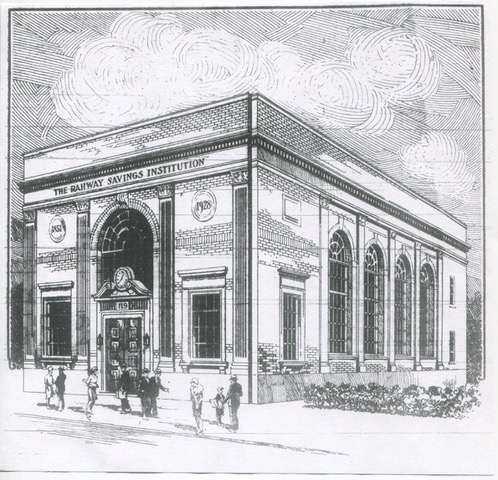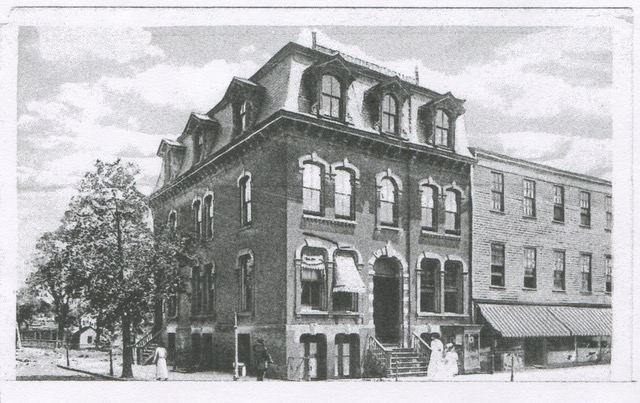
171 Year History of Rahway Savings
Submitted by Al Shipley, City Historian and Rahway Library Research Consultant
When the news broke this past December that RSI Bank had signed a merger agreement with Columbia Bank, a collective gasp of surprise and dismay could be felt throughout the city. For many Rahway residents and for patrons from surrounding communities, RSI/Rahway Savings was the only bank they ever knew. It was the bank where they opened their first savings account, where they kept a Christmas Club, where they got a mortgage for their home. The downtown area would change many times over the decades, yet the bank remained a constant and steady institution that served generations. The prospect of losing RSI was akin to losing a long-time, trusted friend.
Incorporated on February 19, 1851, Rahway Savings was the town’s second bank preceded only by the Farmers and Mechanics Bank which opened in 1828. The original home of Rahway Savings was a tiny, narrow, two-story structure squeezed between two retail establishments on Main Street opposite Cherry Street. The bank’s first president was William C. Squier who held the position for over 50 years, a testament to the stability of the Institution. The business thrived over the next sixteen years and in 1867 the bank moved into a new three-story building on Main Street at the corner of Monroe. The bank occupied the entire first floor with city hall offices and courtroom chambers on the second and third floors. There was so much activity in the building that the location became known as “Savings Bank Corner.” By the turn of the century Rahway Savings had earned the reputation as the “Bank of Strength” and was regarded as one of the strongest and most successfully managed savings banks in the state.
Rahway’s downtown was changing, however, and by the 1920s Irving Street, with three banks located between the railroad elevation and Milton Avenue, had replaced Main Street as the financial district of the city. To keep up with the changing times and to expand their services, Rahway Savings bought property on Irving Street and built a new home next to St. Paul’s Church. The handsome neo- classical styled bank, which was designed by Rahway architect Seymour Williams, opened on Saturday, December 28, 1928.
Business at the new location continued to prosper and over the next several decades the bank would become known as the “Friendly and Progressive Bank.” By the 1950s more changes in the banking business were occurring and bank officials were again faced with the need to find larger quarters to accommodate expanding operations and offerings. In 1959 a building committee was appointed to recommend improvements to the facility and the advisability of purchasing additional property. Many suggestions were proposed, but no major changes in the building would take place until August 14, 1971 when ground was broken for an addition that would be almost three times as large as the original structure. The addition would include nine teller windows, more office space, and a three car, covered drive-thru area.
When designing the addition, architects were faced with the challenge of creating a façade that would combine the old and the new as it was imperative to bank officials that the large, modern addition would blend in with the smaller original building. Through the use of brown bricks, enhanced by white Danby marble imported from quarries in Vermont, and the replication of vertical columns and window treatment, the challenge was beautifully and skillfully met.
In 1988 a second major addition was made which enlarged the lobby space, improved the design of the teller area, added more offices and a conference room on the second floor, and enlarged the drive-thru area. The final piece of the RSI building was added in 2011 when the Mortgage Department was constructed on the corner of Irving and Broad Street. The handsome beauty of the entire complex was maintained by using the same materials on each addition, thus keeping the unified appearance.
In the long history of the bank there have only been eight presidents, each with the same philosophy of looking to the future in order to share in the growth of the city and to afford better services to their depositors. Even as RSI was preparing its transition, it was done with the best interests of the community and its customers in mind. To this end, the bank will be establishing and funding a new charitable foundation in the amount of five million dollars to continue to support the many charitable and civic organizations that serve the communities. David R. Taylor, President and Chief Executive Officer of RSI, recently commented in part, “The merger will provide an opportunity for our customers to join a larger banking network with expanded products and services.” Although all things must come to an end, it will feel strange transacting business in a new bank, and it will take a long time before the ‘Friendly, Progressive Bank,” the “Bank of Strength,” is forgotten. It will be like losing a friend.


